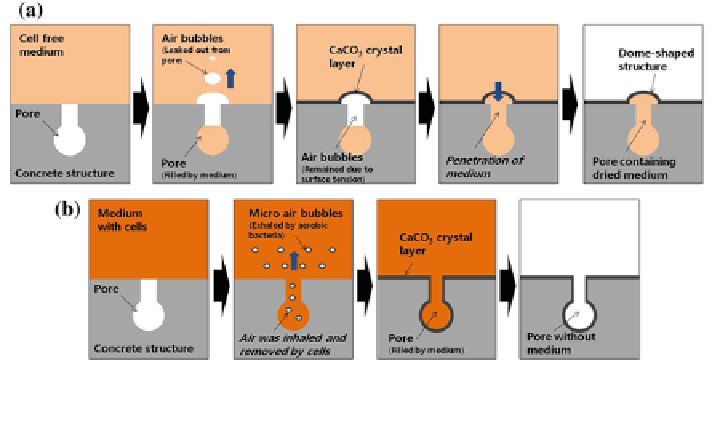Environmental Engineering Reference
In-Depth Information
Fig. 16.2 Top surfaces of concrete specimens treated by water: a normal concrete and
b lightweight concrete; top surfaces treated by cell-free medium: c normal concrete and
d lightweight concrete; top surfaces of concrete specimens treated by medium with S. pasteurii:
e normal concrete and f lightweight concrete; top surfaces of concrete specimens treated by
medium with B. sphaericus: g normal concrete and h lightweight concrete photographed by using
a digital camera (height 23 mm, width 30 mm). Reprinted from Kim et al. (
2013
), Copyright
(2013), with permission from Elsevier
b
Fig. 16.3 a Dome-shape structure formation when being treated with cell-free medium, b crystal
layer formation when being treated with cells. Reprinted from Kim et al. (
2013
), Copyright
(2013), with permission from Elsevier
In addition, the fact that fewer bubbles arose in medium with bacteria was also
attributable to the fact that the bacteria metabolized the proteins. For instance, B.
sphaericus metabolized glucose via a metabolic process (Massie et al.
1985
),
possibly acting as a surfactant (Bam et al.
1995
), which could then hinder the
formation of air bubbles.
Meanwhile, the precipitations of calcium carbonate differed slightly depending
on the type of bacteria. The medium with S. pasteurii showed the precipitation of
very fine calcium carbonate powders (Fig.
16.3
e and f). On the other hand, the
medium
with
B.
sphaericus
precipitated
thick
calcium
carbonate
layers
(Fig.
16.3
g, h).
16.3.2 Microstructures of Precipitated Calcium Carbonate
Figures
16.4
,
16.5
,
16.6
,
16.7
,
16.8
,
16.9
and
16.10
show SEM images and the
EDS spectra of the surfaces of normal and lightweight concrete specimens treated
with liquid media with and without bacteria. In the case of the cell-free medium,

Search WWH ::

Custom Search